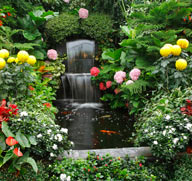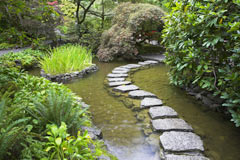Updated February 26, 2014.
The aim of a meditation garden is to provide a place for retreat.
Natural environments have a wonderful healing touch. They can help us relax and unwind after a hard day’s work with little effort on our part. A consciously designed meditation garden amplifies this experience of calm. Read the following tips from How to Make a Meditation Garden on wikiHow.
How to Create a Meditation Garden?
The great thing about a meditation garden is that you don’t even have to know anything about meditation to create one. The natural space evokes the very essence of calmness on its own and all you need to do is visit it to feel relaxed and at peace. Follow these guidelines for inspiration and practical steps to creating a meditation garden.
Imagine what a restful garden would look like to you. There is no right or wrong way to make a meditation garden; the whole goal is to make a garden that both calms and inspires you and when you open your eyes, inspires you even more. Try to see this garden as an “outdoor room”. It’s a place where you’ll go to relax, rest, and recline, so it will need to have features in it that you find comfortable, comforting, and secure from prying eyes. 
Think about what you love about being in the area in terms of relaxing and offloading your stress. Take those memories and feelings and translate them into practical ideas of how you would like to see a personal garden aimed totally at relaxation and peace. If any ideas occur, (for example, a blue and yellow theme would be attractive to you, or a wooden park bench), incorporate those things into your imagined garden. If you are going to share this garden with family or others, get their ideas and input too. And always remember that this is your garden; it’s your intent that counts when creating a meditation garden.
You might find really good inspiration in traditional gardens from other parts of the world. While there is no need to follow a theme, having one can instill a sense of calmness through orderliness and focus. There are several ways to find out what types of gardens are grown elsewhere: borrow library books showing pictures, look online for images, visit open gardens that feature specific examples, or visit your local Botanical Gardens or specialized public areas for inspiration. Think about the elements in these gardens that inspire feelings of peace and happy solitude in you. Some gardens to consider include:
 Japanese – this could incorporate sand or fine gravel patterns, Zen elements, cherry blossom, the Japanese maple tree, and geometric simplicity.
Japanese – this could incorporate sand or fine gravel patterns, Zen elements, cherry blossom, the Japanese maple tree, and geometric simplicity.- Chinese – this could incorporate a fish pond, overhanging trees, little bridges, tiny pagodas, natural stone sculptures (ie: non-carved stone) and pathways.
- Southwestern USA desert – this could incorporate simplicity, cacti, water-hardy plants (great for a garden in an area low in water), and a shady tree.
- Traditional English – think about a walled garden in a university town like Oxford, Cambridge, or Durham as an example.
- Australian native – this could include gum trees, Australian natives (look for the fragrant plants to awaken your senses), and lots of shaded areas to cut out the heat of the sun. Eucalyptus trees are great for listening to the sound of the breeze as well as for their scent.
- North American – this could be filled with carved wooden items; maple, fir, birch, and oak trees; lots of deciduous colors in the fall; plenty of plants and feeders for the birds to feed on, and so forth.
- Other minimalist type plans including “Middle Eastern” or “Islamic” gardens and many other different variations are ideal formats.
- Size: Work out how large your area is so that you can work according to its size. And, unless you live alone, your garden will be used by other people, so it’s a good idea to also plan how you will divide your space from the regular hustle bustle of the rest of the garden. Think about how you will make obvious divisions using such items as potted plants in rows, hedgerows, large palms, benches, fencing, and so forth.
- Sound levels: Consider how silent it is already, or whether you might need to create buffers using fences, hedges, embankments, or other sound-muffling structures. If you are in a reliably quiet neighborhood you probably have a natural advantage. Sound can be an annoying hindrance or an object of focus for meditation.
- Terrain: Is the land sloped, hilly, flat, grassy, or largely soil? All of these factors will create particular needs and issues of their own that you’ll need to work with them to create a sense of peace and comfort.
- Views: What views exist in your garden that you might wish to make use of as a feature point and find ways to “frame”. The view might be the horizon, or a lovely group of trees, or anything else that inspires you. If you have none of these, consider a green bamboo hedge (clumping forms) to hide a lack of view, or the mundane everyday things like the compost bin, a neighbor’s wall or an ugly fence.
Start a plan. Incorporate all the positive attributes of your existing area (for example, you might already have a pleasant quiet area or a fish pond that you can work around), and begin planning for the desired features that you haven’t yet got. On a large piece of paper, draw an outline of how you perceive your garden, including the features you intend to add. This plan can be updated and changed as you proceed, but it’s a good idea to begin with a basic idea to work from.
Use structures and tree lines as sanctuary creators. Throughout history, people have used small garden buildings such as summerhouses, loggia, pergolas, and tree-lined areas and entrances to create little havens of peace or to calm the eye when viewed. In adding such structures (both living and inanimate), you create beauty and functionality at once:
- Plant a “grove” area. This is a small secluded patch of trees lined up either at the end of a lawn, down a pathway, or in some other formation that works well within the garden space.
- Vine arbors and pergolas are a cross between the garden space and indoor space. They can provide shelter from sun, wind, and rain, as well as adding incredible depth and beauty to a garden space.
- Consider a courtyard. This semi-enclosed environment might be ideal for marking out your sanctuary with clarity and for creating barriers against external movement and sounds.
- Add a summerhouse, loggia, or an enclosed pavilion. Places that provide shelter from the sun and the rain are ideal additions to a meditation garden; if it’s too noisy, hot, wet, or cold in your garden, consider building an enclosed pavilion. The beauty of having a pavilion or summer house type structure is that you can fill it with soft furnishings such as a mat, cushions, pillows, etc., to make it a comfortable sanctuary for lying and resting in, no matter what the time of year may be.
Think about the surfaces. If you’re going to be relaxing in this garden, the surface upon which you walk, sit, lie down, and relax matters a great deal. Surfaces that are too hot, cold, or hard will affect your experience, so plan this part with great care. Some surfaces to consider include:
- Soft, grassy surfaces – this could be created by lawn, native grasses, chamomile, button grass, etc.
- Bricks – lovely old bricks make a wonderful sun-warm surface. Over time bricks attract moss, lichen, etc. That may or may not be to your liking, but it does add character over time and it creates a sense of oneness with nature.
- Pavers – these can be hit and miss if chosen poorly. Older, handmade ones can be lovely. Be very careful with choosing pavers; they can look fantastic if you create patterns with them and weave them in among other surfaces, and not just rely on them alone.
- Mosaics – if you have the time and money for mosaics, these can be used to make a small (or large!) part of the meditation garden. Choose designs that are meaningful to you.
- Other possible surfaces include pebbles, wood, slate, gravel (very fine), sand, patterned paving.
- Complexity is best used according to the character of the person. Too much can be distracting to some, too little can be uninspiring to others. A highly complex image can be an object of focus, functioning much like a mandala.
Invest in objects that will increase the sense of serenity in the garden. There are numerous garden-friendly items that will help to really. Ideal additions include:
- Water features – water is calming and relaxing, both when it is settled and when it is moving. You might consider water bowls, fish ponds, a fountain, a trickling water feature, or other items that use or display water.
- Rocks – rockeries, rock sculptures, Inukshuks, and other uses of rocks can help add to the solidity and steadiness of your peaceful garden zone.
- Small plinths or altars – these can be ideal places for you to place a candle, a vase of flowers, make a small shrine, or leave incense, candles or other spiritual offerings if that is your wish. Who you offer them to isn’t really the matter at hand, it is the intention behind it that counts, but it’s still best to pick one that inspires calmness in you.
- Statues – there are many possibilities with statues; simply choose those that instill a sense of peace in you. Buddha images or statues and small pagodas are good ideas, but only if they work for you.
- Sculptures – look for local artists whose work pleases you; this is a great way to support local artists as well as gaining something unique and special for your garden.
- Specific empty spaces. These are little areas which are surprisingly restful as these are places which don’t need anything to fill them.
Choose plants that inspire you. English cottage garden type plants are just as valid as minimalist gardens which have very few, if any, plants. The plants you choose can be scented, flowering, herbal, tropical, native or even desert style. The most important thing is that the plants should evoke calmness in you. Plant forms can inspire you. When choosing plants look at the shapes, patterns, lines, and colors to inspire a sense of peacefulness as well as something to concentrate upon when meditating.
English cottage garden type plants are just as valid as minimalist gardens which have very few, if any, plants. The plants you choose can be scented, flowering, herbal, tropical, native or even desert style. The most important thing is that the plants should evoke calmness in you. Plant forms can inspire you. When choosing plants look at the shapes, patterns, lines, and colors to inspire a sense of peacefulness as well as something to concentrate upon when meditating.
Use eco-friendly garden solutions and products. A meditation garden is a place to be at one with nature and the Earth; it wouldn’t make sense to drown it in chemicals such as pesticides (insecticides), fungicides, anti-microbials and rodenticides. If you are practicing a philosophy of non-harm, or a virtue system such as Buddhist precepts using such toxins can affect the quality of the meditation as well as your well-being. Instead, look for the eco-friendly options to keep weeds and other pests under control within your garden, as well as using eco-friendly plant nutrient options.
Keep updating and changing your meditation garden to suit your needs. As with meditation itself, which helps you to grow and change over time, your garden should not be stuck in time. Replenish and refurbish your meditation garden as your own needs and wants evolve.
And finally, when meditating, select an area that is cool, calm, dry and preferably quiet. Close your eyes, relax, focus and just let the meditation happen. Do not try to stop your thoughts from racing, as struggling with them makes it worse. Simply allow them to flow and fade.
You can read the original article in full here. Content on wikiHow can be shared under a Creative Commons License.
Do you have a meditation garden? What did you do to make it special?


